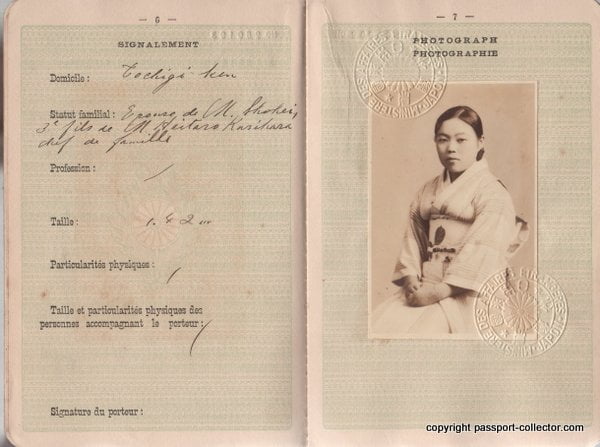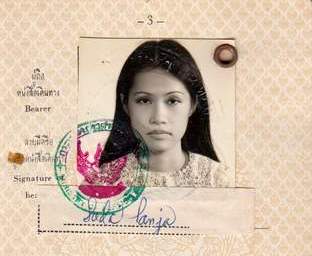100 Years Passport Photo
100 Years Passport Photo
2015 was actually the 100th anniversary of the passport photo, but it was unfortunately not much communicated or even celebrated. Only the British newspaper “The Sunday Post” published a brief article in March 2015. The history of Man’s most traveled document is quite impressive, entertaining, and educating at the same time. Here are some facts about the passport photo you might don’t know before.
The passport photo is since “just” 100 years a significant characteristic of any issued passport. The variations of photos were extensive when introduced in 1915. The exact date for launching the passport photo in German passports by law was 1. January 1915.
However, in the beginning, there were no rules on how a passport photo should look like. So you can find the most exciting photos from this time. For me, such early passports are ART as no passport (photo) looked the same considering the handwriting, the colorful stamps and revenues, and of course, the picture itself.
Before passport photos were introduced, there was only a description of the bearer. Only the British passport was for more than 100 years, the only passport without such a description of the holder. Then typically saying, “Mr. Peter Parker, a British subject, traveling on the continent.”
The description looked like that:
- Age
- Stature: e.g., small, tall, etc
- Hair: color, bald, etc
- Eyes: color
- Face: e.g., round, oval, etc
- Distinguishing marks: e.g., scar, tattoo, missing finger, etc
This was, of course, not much accurate, except for a truly outstanding distinguishing mark. Introducing a photo into a passport improved the verification of its bearer significantly (in combination with the personal description). However, passport photos were not standardized in the beginning, and so you can find all variations of photos.
E.g., people standing in the park (full-size photo), sitting on a bench or a horse, or showing them playing guitar. Photos with hats were widespread. Also, the sizes of a photograph were not defined, and all sizes were possible as long there was a place to mount them into a passport.
Here are some examples…


By 1926 the rule of “full face, without a hat” was implemented in the UK, and the size of images had been specified. 100 Years Passport Photo

Another very unusual photo is this one in an Andorran passport from 1942! Color or colorized photos were not ordinary at all at this time, so this is also an excellent example of the early use of a color photo. 100 Years Passport Photo

Passport photo rules became more strict in the 1960s (USA). You could not SMILE anymore in a passport photo. Another radical change was the switch to color photos, probably the end of the 1970s, which substantially increased the identifying accuracy of the photograph. 100 Years Passport Photo

While passport photos had an “official character,” people were wearing back then more often a suit and tie. Also, this changed over time, and the “dress code” was more relaxed. 100 Years Passport Photo
In the 21st century, the passport doesn’t contain a laminated photo print anymore. Instead, the entire page/photo has been digitally generated. This supports, of course, fraud and forgery — several security features like a hologram, watermark, and microprinting protecting the digital photo. 100 Years Passport Photo


Indeed, the idea of the photograph as a physical object with some authenticity or history has been erased. Who knows if passports will be around in 20 years? They may become artifacts of the “print era,” along with the vast majority of other photographs that used to be printed but are now seen only on screens. 100 Years Passport Photo
FAQ Passport History
Passport collection, passport renewal, old passports for sale, vintage passport, emergency passport renewal, same day passport, passport application, pasaporte passeport паспорт 护照 パスポート جواز سفر पासपोर्ट
1. What are the earliest known examples of passports, and how have they evolved?
The word "passport" came up only in the mid 15th Century. Before that, such documents were safe conducts, recommendations or protection letters. On a practical aspect, the earliest passport I have seen was from the mid 16th Century. Read more...
2. Are there any notable historical figures or personalities whose passports are highly sought after by collectors?
Every collector is doing well to define his collection focus, and yes, there are collectors looking for Celebrity passports and travel documents of historical figures like Winston Churchill, Brothers Grimm, Johann Wolfgang von Goethe. Read more...
3. How did passport designs and security features change throughout different periods in history, and what impact did these changes have on forgery prevention?
"Passports" before the 18th Century had a pure functional character. Security features were, in the best case, a watermark and a wax seal. Forgery, back then, was not an issue like it is nowadays. Only from the 1980s on, security features became a thing. A state-of-the-art passport nowadays has dozens of security features - visible and invisible. Some are known only by the security document printer itself. Read more...
4. What are some of the rarest and most valuable historical passports that have ever been sold or auctioned?
Lou Gehrig, Victor Tsoi, Marilyn Monroe, James Joyce, and Albert Einstein when it comes to the most expensive ones. Read more...
5. How do diplomatic passports differ from regular passports, and what makes them significant to collectors?
Such documents were often held by officials in high ranks, like ambassadors, consuls or special envoys. Furthermore, these travel documents are often frequently traveled. Hence, they hold a tapestry of stamps or visas. Partly from unusual places.
6. Can you provide insights into the stories behind specific historical passports that offer unique insights into past travel and migration trends?
A passport tells the story of its bearer and these stories can be everything - surprising, sad, vivid. Isabella Bird and her travels (1831-1904) or Mary Kingsley, a fearless Lady explorer.
7. What role did passports play during significant historical events, such as wartime travel restrictions or international treaties?
During war, a passport could have been a matter of life or death. Especially, when we are looking into WWII and the Holocaust. And yes, during that time, passports and similar documents were often forged to escape and save lives. Example...
8. How has the emergence of digital passports and biometric identification impacted the world of passport collecting?
Current modern passports having now often a sparkling, flashy design. This has mainly two reasons. 1. Improved security and 2. Displaying a countries' heritage, icons, and important figures or achievements. I can fully understand that those modern documents are wanted, especially by younger collectors.
9. Are there any specialized collections of passports, such as those from a specific country, era, or distinguished individuals?
Yes, the University of Western Sidney Library has e.g. a passport collection of the former prime minister Hon Edward Gough Whitlam and his wife Margaret. They are all diplomatic passports and I had the pleasure to apprise them. I hold e.g. a collection of almost all types of the German Empire passports (only 2 types are still missing). Also, my East German passport collection is quite extensive with pretty rare passport types.
10. Where can passport collectors find reliable resources and reputable sellers to expand their collection and learn more about passport history?
A good start is eBay, Delcampe, flea markets, garage or estate sales. The more significant travel documents you probably find at the classic auction houses. Sometimes I also offer documents from my archive/collection. See offers... As you are already here, you surely found a great source on the topic 😉
Other great sources are: Scottish Passports, The Nansen passport, The secret lives of diplomatic couriers
11. Is vintage passport collecting legal? What are the regulations and considerations collectors should know when acquiring historical passports?
First, it's important to stress that each country has its own laws when it comes to passports. Collecting old vintage passports for historical or educational reasons is safe and legal, or at least tolerated. More details on the legal aspects are here...
Does this article spark your curiosity about passport collecting and the history of passports? With this valuable information, you have a good basis to start your own passport collection.
Question? Contact me...

